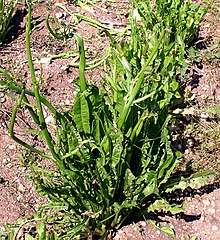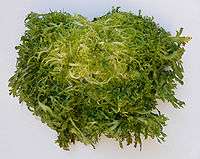Endive
Endive (/ˈɛndaɪv, -dɪv, ˈɑːndiːv/)[1] is a leaf vegetable belonging to the genus Cichorium, which includes several similar, bitter, leafed vegetables. Species include Cichorium endivia (also called endive), Cichorium pumilum (also called wild endive), and Cichorium intybus (also called common chicory). Common chicory includes types such as radicchio, puntarelle, and Belgian endive.

| Nutritional value per 100 g (3.5 oz) | |
|---|---|
| Energy | 71 kJ (17 kcal) |
3.35 g | |
| Dietary fiber | 3.1 g |
0.2 g | |
1.25 g | |
| Vitamins | Quantity %DV† |
| Vitamin A equiv. | 14% 108 μg12% 1300 μg |
| Thiamine (B1) | 7% 0.08 mg |
| Riboflavin (B2) | 6% 0.075 mg |
| Niacin (B3) | 3% 0.4 mg |
| Pantothenic acid (B5) | 18% 0.9 mg |
| Folate (B9) | 36% 142 μg |
| Vitamin C | 8% 6.5 mg |
| Vitamin E | 3% 0.44 mg |
| Vitamin K | 220% 231 μg |
| Minerals | Quantity %DV† |
| Calcium | 5% 52 mg |
| Iron | 6% 0.83 mg |
| Magnesium | 4% 15 mg |
| Manganese | 20% 0.42 mg |
| Phosphorus | 4% 28 mg |
| Potassium | 7% 314 mg |
| Zinc | 8% 0.79 mg |
| |
| †Percentages are roughly approximated using US recommendations for adults. Source: USDA Nutrient Database | |
There is considerable confusion between Cichorium endivia and Cichorium intybus.[2][3]
Cichorium endivia
There are two main varieties of cultivated C. endivia endive:
- Curly endive, or frisée (var crispum). This type has narrow, green, curly outer leaves. It is sometimes called chicory in the United States and is called chicorée frisée in French. Further confusion results from the fact that frisée also refers to greens lightly wilted with oil.
- Escarole, or broad-leaved endive (var latifolia), has broad, pale green leaves and is less bitter than the other varieties. Varieties or names include broad-leaved endive, Bavarian endive, Batavian endive, grumolo, scarola, and scarole. It is eaten like other greens, sauteed, chopped into soups and stews, or as part of a green salad.
 Frisée
Frisée
Cichorium intybus
Cichorium intybus endive is popular in Europe, and is also known as leaf chicory.
Chemical constituents
Endive is rich in many vitamins and minerals, especially in folate and vitamins A and K, and is high in fiber. It also contains kaempferol.[6]
References
- Jones, Daniel (2011). Roach, Peter; Setter, Jane; Esling, John (eds.). Cambridge English Pronouncing Dictionary (18th ed.). Cambridge University Press. ISBN 978-0-521-15255-6.
- "Chicory and Endive". Innvista. 2013-07-31. Retrieved 2013-08-18.
- "Endive | Archives | Aggie Horticulture". Plantanswers.tamu.edu. Retrieved 2013-08-18.
- Anderson, B. (2001), The Foods of Italy: The Quality of Life, Italian Trade Commission, p. 147
- Kasper, L.R. (1999), The Italian Country Table, Scribner, ISBN 9780684813257
- DuPont, M. S., Day, A. J., Bennett, R. N., Mellon, F. A., Kroon, P. A., Absorption of kaempferol from endive, a source of kaempferol-3-glucuronide, in humans, Eur J Clin Nutr 2004 Jun;58(6):947-54
External links


- Chisholm, Hugh, ed. (1911). . Encyclopædia Britannica (11th ed.). Cambridge University Press.


